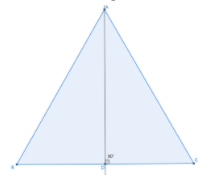
In an equilateral triangle ABC, AD$ \bot $ BC. Prove that $A{D^2} = 3B{D^2}$.
Answer
511.5k+ views
Hint: The altitude is also the median for an equilateral triangle. Use this property and the Pythagoras theorem (the square of the hypotenuse is the sum of the squares of the other two sides, in a right-angled triangle) to prove what is required.
ABC is an equilateral triangle. AD is perpendicular to BC.
AD$ \bot $ BC. So, AD is the altitude of triangle ABC.
Let us draw the diagram.

We know that, in an equilateral triangle the altitude is also the median.
Hence, D is the midpoint of BC.
BD=DC
We can also say that BD is half the length of BC.
$BD = \dfrac{1}{2}BC$ …(1)
We will use the Pythagoras theorem which states that the square of the hypotenuse is the sum of the squares of the other two sides, in a right-angled triangle.
In triangle ADB, AB is the hypotenuse.
$A{B^2} = B{D^2} + A{D^2}$
By rearranging we get,
$A{D^2} = A{B^2} - B{D^2}$ …(2)
We know that, in an equilateral triangle, all the sides are equal.
So, BC=AB …(3)
Using (3) in (1) we get,
$BD = \dfrac{1}{2}AB$
By cross-multiplying we get,
$AB = 2BD$ …(4)
Using (4) in (1) we get,
$
A{D^2} = {(2BD)^2} - B{D^2} \\
A{D^2} = 4B{D^2} - B{D^2} \\
A{D^2} = 3B{D^2} \\
$
Hence, $A{D^2} = 3B{D^2}$ is proved.
Note: In problems where we have to prove LHS=RHS, start from the LHS and take the proof in that direction as expressing the terms in terms of what is given in the RHS. This will lead to getting the correct RHS. Reasons must be written for each step while proving.
ABC is an equilateral triangle. AD is perpendicular to BC.
AD$ \bot $ BC. So, AD is the altitude of triangle ABC.
Let us draw the diagram.

We know that, in an equilateral triangle the altitude is also the median.
Hence, D is the midpoint of BC.
BD=DC
We can also say that BD is half the length of BC.
$BD = \dfrac{1}{2}BC$ …(1)
We will use the Pythagoras theorem which states that the square of the hypotenuse is the sum of the squares of the other two sides, in a right-angled triangle.
In triangle ADB, AB is the hypotenuse.
$A{B^2} = B{D^2} + A{D^2}$
By rearranging we get,
$A{D^2} = A{B^2} - B{D^2}$ …(2)
We know that, in an equilateral triangle, all the sides are equal.
So, BC=AB …(3)
Using (3) in (1) we get,
$BD = \dfrac{1}{2}AB$
By cross-multiplying we get,
$AB = 2BD$ …(4)
Using (4) in (1) we get,
$
A{D^2} = {(2BD)^2} - B{D^2} \\
A{D^2} = 4B{D^2} - B{D^2} \\
A{D^2} = 3B{D^2} \\
$
Hence, $A{D^2} = 3B{D^2}$ is proved.
Note: In problems where we have to prove LHS=RHS, start from the LHS and take the proof in that direction as expressing the terms in terms of what is given in the RHS. This will lead to getting the correct RHS. Reasons must be written for each step while proving.
Recently Updated Pages
What percentage of the area in India is covered by class 10 social science CBSE

The area of a 6m wide road outside a garden in all class 10 maths CBSE

What is the electric flux through a cube of side 1 class 10 physics CBSE

If one root of x2 x k 0 maybe the square of the other class 10 maths CBSE

The radius and height of a cylinder are in the ratio class 10 maths CBSE

An almirah is sold for 5400 Rs after allowing a discount class 10 maths CBSE

Trending doubts
The Equation xxx + 2 is Satisfied when x is Equal to Class 10 Maths

Why is there a time difference of about 5 hours between class 10 social science CBSE

Change the following sentences into negative and interrogative class 10 english CBSE

Write a letter to the principal requesting him to grant class 10 english CBSE

Explain the Treaty of Vienna of 1815 class 10 social science CBSE

Write an application to the principal requesting five class 10 english CBSE




